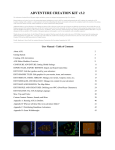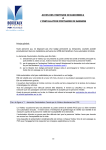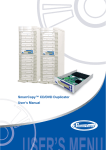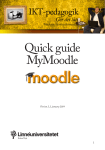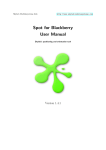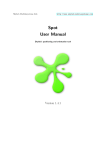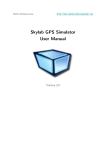Download MBD Manual
Transcript
Marine Bacterioplankton Database (MBD) Global Positioning of Marine Bacterioplankton (GPMB) MBD / GPMB User’s Manual Introduction MBD/GPMB is the result of a project done for the University of Kalmar, Department of Biology and Environmental Science. The department wished for a system that could store and manage DNA-sequences. The system should also be able to administrate from the Internet. A graphical interface for displaying the data in the system should be implemented. The most fundamental part of the system is a relational database. This database is easily administrated using a web-interface created with JSP-code. The graphical presentation is realized with a Java-applet. This user’s manual will describe the functionality of MBD/GPMB and how the system is managed. There will be short examples of how certain tasks are done and things to consider when administrate the system. The user’s manual is divided into two parts, MBD and GPMB. In the MBD-part the whole administration interface will be described. More limited and easy accessible guidance is provided on the homepage of the database. This product includes software developed by the Apache Software Foundation (http://www.apache.org/). The software used is the web servers Apache and Tomcat. The database that is being used by the system is MySQL. The following web browsers have been tested and work with the system. • • • • • • Safari v 1.0, Mac OS X Internet Explorer 5.2, Mac OS X Internet Explorer 6.0, MS Windows XP Internet Explorer 5.5, MS Windows 2000 Mozilla 1.4, MS Windows XP Opera 7, MS Windows XP Because of the use of code that follows well implemented standards it is most likely for the system to work when using different web browsers than the ones that are mentioned above. 2 1 MBD 1.1 Database The database that is used in this system is MySQL. MySQL is free to use in the means that it is implemented in the system. The database is integrated in the system, but it is run as a standalone component. This means that even if other parts of the system should fail, the database will most likely be accessible. Under normal circumstances there is no direct contact from a user with the database, instead the communication is done by the system itself. There is, however, a way to administrate the database directly through a third party software called phpMyAdmin. This way of administrating the database is extremely risky and should only be used as a last solution. More information about phpMyAdmin can be found under the heading phpMyAdmin under Administration interface. 1.2 Administration interface As mentioned before the administration interface is created using JSP. This makes it necessary to have a working web server to use the interface. 1.2.1 Users The system has four different users. Each and every one of these users has special permissions. 1.2.1.1 admin This user has the full control of the system. The admin user can view and update all of the data in the database. The admin user also has the possibility to add new data in the database. It is the admin user who has to confirm newly submitted sequences before they become active in the system. This part will be elaborated under the section Confirm newly submitted sequences. The BLAST-tool will compare a given sequence to all the sequences in the database when the admin user uses it. 1.2.1.2 mme The mme user is the normal account used by the MME-group. This user has the right to view sequences that are owned by the mme user. Besides viewing the owned data the mme user have the right to view data that are already published. I. e. the data that is accessible to the public. When the mme user uses the BLAST-tool the given sequence is compared with mmeowned and public sequences. 1.2.1.3 basics The basics user has similar options like the mme user. The main difference is that the basics user have an own tab in the graphical presentation. This tab is only activated when the admin user or the basics user starts the graphical presentation. The BLAST-tool compares a given sequence to the basics owned and public sequences. 1.2.1.4 public When a user visits the page he or she will automatically be logged on as the public user. This user has access to public data that is stored in the database. The public user can use the 3 BLAST-tool and it will compare the given sequence with the sequences that are owned by public. The public user can at any point choose to log into the system as a different user. 1.2.2 Log into the system All users except the public user must log into the system to have access to their specific services. The active session in the open web browser is connected to the login. There are several ways to find a login screen. The first option is found on the start page. Another way is to simple press the menu option “login”, and the third way to access a login function is to click a secure page and follow the link that is presented, see screenshot below. Fig. 3.1, This is the login screen. Fig. 3.2, This message is shown when a user with limited rights try to access a secure page. 1.2.3 Functions There are several menu options available and most of the options below can be accessed by all users. There is of course a significant difference of the search results that a public user gets and an administrator, but this is not noticeable to the individual user. Here follows an explanation of each and every one of the menu options. Fig. 3.3,These are the available menu options. 1.2.3.1 start This is the start page that is displayed when first visiting the mbd/gpmb site. This page shows information about the site and shows a login screen. 4 1.2.3.2 GPMB The GPMB option leads the way to a start page for the Java-applet. In close proximity to the start button there is a label telling which user the applet will start with. To see additional information about starting the applet, please read Starting the applet later in this manual. 1.2.3.3 browse There are several search options and these can be found under the browse option in the menu. • • • • • • • • Accession Number ID Number GI Locus Definition Taxonomy Contig Number Region Modification It is possible to use free text search with every search option. When the search results is greater than one a dropdown box is shown that contains all search results. There is also an option to cycle through the search results. 1.2.3.4 blast The BLAST tool is rather simple to use. Its user interface consists of a text area where the sequence that should be compared is entered. A button under this text area activates the BLAST-function, who takes about 2-5 seconds to execute. When the BLAST tool is finished executing, the result is shown. The result contains active links to sequences that is included in the result. This link brings up the browse option with the current sequence active. Please note that the BLAST tool uses different base of sequences to compare the entered sequence with. For further reading, please read under Users earlier in this manual. 1.2.3.5 submit sequence This option displays a number of text fields that can be entered to submit new sequences to the system. The new sequence is placed in a queue and must be confirmed by the administrator to be stored in the active part of the database. This is further explained under Confirm new sequences later in this manual. 1.2.3.6 admin The options under admin are only available to the administrator. If any other user tries to access this option an error message is displayed. 5 Fig. 3.4, This pictures shows the options available under the admin menu. 1.2.3.6.1 View and update This option is very similar to the browse function. The main difference is that this option gives the possibility to edit the values. The View and Update page is divided into two parts. The upper part represents the current selected contig. The lower part displays the sequences that the current contig consists of. The reference of the current sequence is also shown here. All the text fields are editable. It is also possible to delete a whole contig or a sequence. To do this the user needs to mark the checkbox that says, “Delete confirmation”. This is done to make sure no data are deleted by mistake. Fig. 3.5, To be able to delete data the user must mark the checkbox “Delete confirmation”. 1.2.3.6.2 Add/remove references to/from a sequence This option is used to add or remove a reference to a sequence. 1.2.3.6.3 Insert sequence This option is the same as submit sequence. This makes it possible to add new sequences into the database. Please note that the values submitted here will not have to be confirmed like the ones the other users submit. 1.2.3.6.4 Insert contig This option is used to insert new contigs in the database. 1.2.3.6.5 Bulk upload Bulk upload makes it possible to upload a comma separated file, containing data, to the system. This file must follow a specific standard to be accepted by the system. The easiest way to create a file that follows the standard is to use the Excel-template provided with the system. There is a link to the Excel-template under this menu option. The template contains different fields where the data need to be entered in a correct format. The easiest way to work with this template is to open it in Excel and enter the data wanted. After all the values are entered the file should be saved as a comma separated file (.csv). 1.2.3.6.6 phpMyAdmin This option opens a new window where phpMyAdmin starts. This tool makes it possible to administrate the database in a rather insecure way. phpMyAdmin should only be used in emergency and when the ordinary web interface is defect. The reason that this tool is so dangerous is that it makes it possible to edit every single table of data in the database. Many tables are connected to each other and if the tables are edited manually, in an incorrect way, 6 this could mean that the connection between the tables could be broken. To be able to use phpMyAdmin the MySQL database and the Apache web server must be running. The users that is used with phpMyAdmin is strictly database users i. e. the users that exist in the MBD/GPMB system is not used here. There are two ways of accessing the phpMyAdmin tool. 1.2.3.6.6.1 Access via the web interface This is the normal way of access phpMyAdmin. There is a link to phpMyAdmin in the admin option. 1.2.3.6.6.2 Access via direct link phpMyAdmin is only to be used in emergency and to be able to access it when the web interface is defective there is a direct link available. http://halia.hik.se:8080/mysqladmin/ 1.2.3.6.7 Confirm newly submitted sequences When new sequences have been submitted to the system by a user different from the administrator the new sequences are queued. The administrator must confirm the new sequences before they are available to the system. When there are new sequences available, the administrator will see a screen, when logging into the system, telling him or her that new sequences are available. The administrator is given the opportunity to inspect and confirm these sequences. If the administrator chooses to inspect and confirm the newly submitted sequences he or she will be presented with a screen that looks similar to this: The options here are to confirm or delete the new sequence. If the administrator chooses to confirm the sequence he or she must first add some information to the sequence. This is done by choosing Edit sequence (see above) and type in which contig the current sequence will be added to. The following screenshot will show how sequence connects to a contig: 7 Fig. 3.6, This function makes it possible to connect a newly submitted sequence to a contig. Additional functionality makes it possible to set the user of the current sequence. This means that only the current owner and of course the administrator have the right to see their own sequences. If the user it set to public all of the users are able to see the new sequence. If no contig is selected to the new sequence and the administrator tries to confirm it to the database, the following error message is shown: A newly submitted sequence can be deleted by marking the checkbox that is found next to the sequence that should be deleted. If the administrator chooses to delete the newly submitted sequence the following message will be shown: 1.2.3.7 login Shows the login screen. 2 GPMB (Java-applet) To be able to use the Java-applet the client computer must have a web browser and Java Virtual Machine version 1.4 or later installed. The applets performance will depend on the client computer and the Internet connection. Faster computer and Internet connections will make the applet faster to work with. Because of the amount of data that the applet needs to download from the systems database the applet may take some time to load and this time will most certainly differ from different client computers. 8 2.1 Start of the applet The menu option GPMB presents some instructions and a start button for the applet. The graphical interface presents different data depending on which user that starts it. The following data are presented for the different users: admin mme basics public Have the right to see all of the samples and sequences in the database. A special BASICS tab is also showed for the administrator. Have the right to see MME-owned and published samples. The BASICS tab is not shown. Have the right to see BASICS-owned and published samples. Have the right to see the BASICS tab. Have the right to see published samples. The BASICS tab is not shown. In close proximity to the start button a label is showing which user the applet will start with. 2.2 Tabs At the top of the applet there are several tabs located. Every tab represents a specific page and by clicking the tab label the current page is shown. 2.2.1 Worldmap This tab shows the world map. At the start the applet shows the current available samples from the database. All of the samples are clickable. When they are clicked a listbox at the bottom of the applet will be populated. The listbox shows the clicked sample and samples that is in close proximity of the clicked sample. The samples in the listbox are clickable and when a sample is clicked another listbox are populated showing which contigs that are available in the clicked sample. When a contig is clicked another listbox is filled with the current contigs sequences. The sequences are clickable and when a sequence is clicked additional information about the selected sequence is shown on the tabs Contig and Reference. 2.2.1.1 Clickable regions The worldmap is divided into several clickable regions. All of the regions are located near or around the coastal line. The borders to these regions are hidden. When a user clicks a region this region is highlighted and all the samples that are not located in the selected region are removed from the map. At the same time the first listbox are filled with the sample that is located in the selected region. From this point it is possible to get additional information in the way described above. 2.2.1.2 Worldmap tab, lower part The lower part of the worldmap tab consists of three different parts. 9 2.2.1.2.1 Reset button When a user has selected a region and clicked on some different samples it might sometimes be useful to reset the worldmap to its original state. This is done by clicking the button marked Reset that is located on the worldmaps lower left. 2.2.1.2.2 Depth indicator All of the samples that are visible on the worldmap is colour coded i. e. a specific colour represent a specific depth. To be able to interpret the colours a legend is provided. This is located in the lower middle part of the worldmap tab. 2.2.1.2.3 Listboxes This part consists if three listboxes that shows the current selected samples, contigs and sequences. All values in the listboxes are clickable. By selecting the exact values wanted more specific information can be extracted from the database. Additional information about the selected values can viewed on the tabs Contig and Reference. 2.2.2 BASICS This tab is only available when the applet is started by an administrator or the BASCIS-user. The reason that the BASICS-tab is protected is that BASICS research findings are considered sensitive information and should not be available to the public. The BASICS tab has the same functionality as the worldmap tab but instead of showing the whole world, a map over Europe is shown. On this map the BASICS owned and public samples are showed. 2.2.2.1 BASICS tab, lower part The lower part of the BASICS tab is identical to the lower part of the worldmap tab. Please see the heading 3.2.1.2 for additional information. 2.2.3 Contig This tab shows information about a special contig. The active contig is determined by the choices made in the Worldmap-, BASICS- or contig-tab. If no contig is selected all the fields are empty. 2.2.4 Reference This tab shows the reference of the selected sequence. The information available are, among others, the author, date of publication and which region a certain sequence belongs to. 2.2.5 Help This tab will show fundamental help how to use the applet. 2.2.6 About This tab shows additional information about the applet and its developers. 10 3 Error Messages/Error handling This system depends on several components and their cooperation. If a component fail or the communication between the components fail the system will generate an error message. The main code in the system is protected by secure interfaces and it is therefore unlikely that a user can damage the system. If an error occurs it is most likely that a service on the server is not running. The two most important components that must be running for the system to function properly are Tomcat and MySQL. If the system is not working properly the following things should be checked: 1. Check that the Tomcat web server is running. 2. Check that MySQL is running. 3. Check that Apache web server is running. If all services mentioned above are running there is a more severe problem in the system and the user should contact someone who is in charge of the system. 3.1 MBD If the database is not running this will be indicated by error messages that are showed when one of the menu options is clicked. If the user enters incorrect values into the web interface an error message will indicate what is wrong with the current value. 3.2 GPMB The applet handles error by showing error messages in the consol to the plugin that runs the applet in the browser. If the applet starts up normally and no values are showed on the map, there is a problem with the connection to the database or the database may not be running. 11











